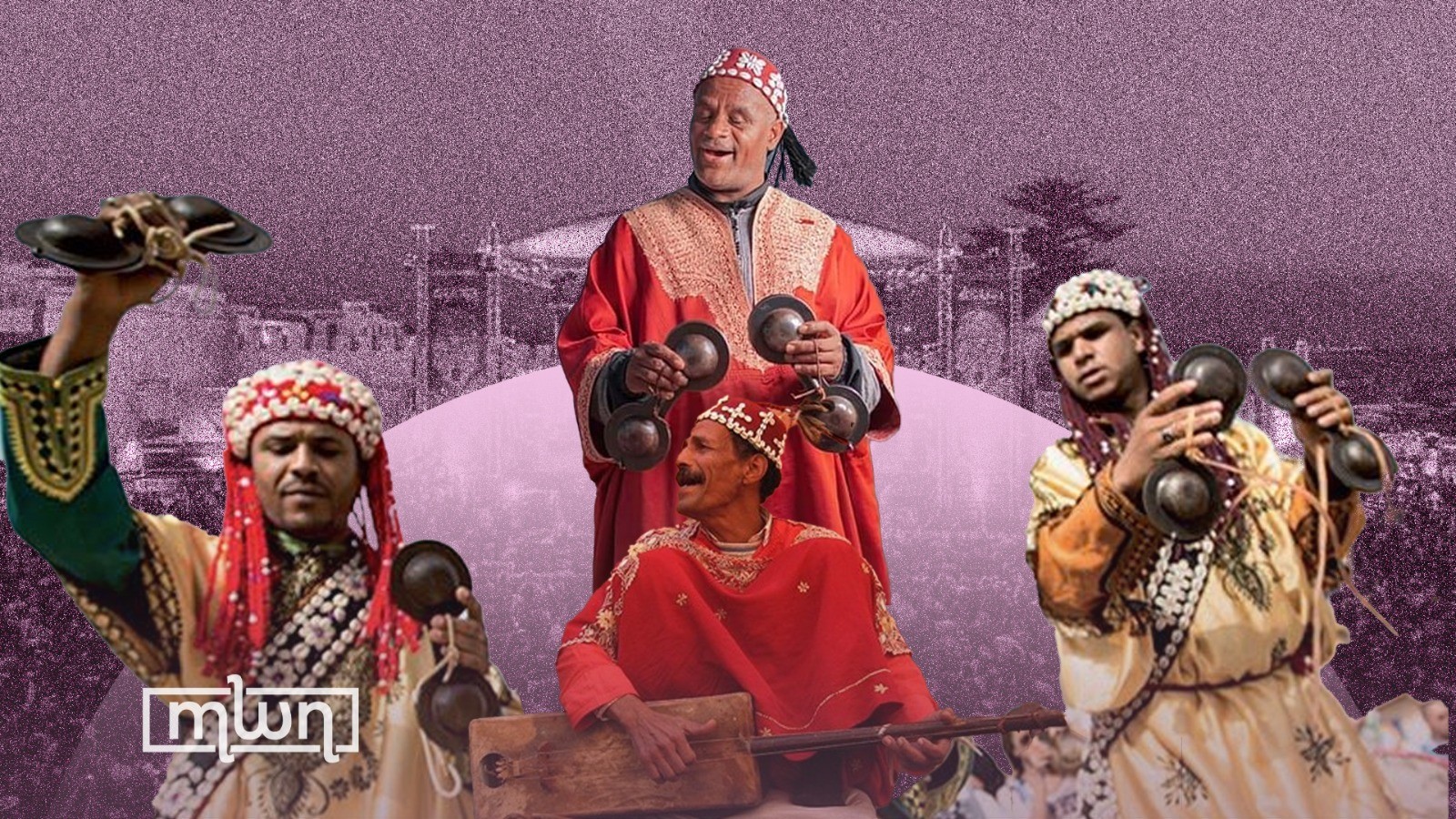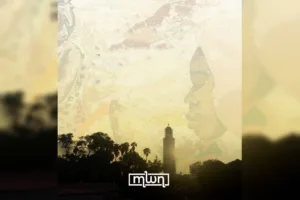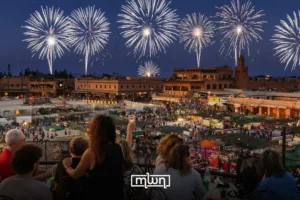Beni Mellal – With just a few days to go before the highly anticipated Gnaoua Festival in Essaouira from June 27-29, there could be no better time to explore and understand the rich history, cultural significance, and unique musical elements of Gnaoua music.
Now in its 25th edition, this traditional music festival is a tribute to African culture and the region’s musical heritage, attracting thousands of visitors from all over the world. It celebrates a tradition which has been inscribed on the UNESCO Representative List of the Intangible Cultural Heritage of Humanity since 2019.
What is Gnaoua music?
Gnaoua music is a captivating blend of spiritual and ritualistic music, originating from the Gnawa ethnic group in Morocco. The term “Gnaoua” refers to both the musical style and the members of the Gnawa community, who are descendants of enslaved people from sub-Saharan Africa. The Gnawa people developed their own distinct musical traditions that combine elements of African ancestral practices, Arab-Muslim influences, and indigenous Amazigh culture.
Gnaoua music is deeply rooted in Sufism, a mystical branch of Islam, and is performed during sacred ceremonies called lila, which aim to heal participants and make peace with the spiritual realm. The music is believed to have the power to invoke spirits, facilitate communication with the divine, and promote physical and spiritual well-being.
The Gnaoua musical tradition is characterized by hypnotic rhythms, entrancing melodies, and powerful vocals. It is often accompanied by ecstatic dancing and trancelike states, as participants seek to connect with the spiritual world and achieve a sense of unity and healing.
History and origins

The Gnawa people trace their origins to sub-Saharan Africa, particularly regions such as Mali, Senegal, Chad, and Nigeria. They were brought to Morocco as slaves starting in the 11th century, and their presence became significant by the 13th century, with over 30,000 black soldiers serving in the Moroccan army.
As the enslaved Gnawa people gradually gained their freedom, either through escape or manumission, they formed their own communities within Morocco. These communities provided a space for the Gnawa to preserve and develop their unique traditions, including their music, which traces its roots back to at least the 16th century. The last remnants of slavery disappeared during the French protectorate in Morocco, although no formal legislation was introduced to abolish the practice.
The Gnawa people practice a mystical, spiritual form of Islam that incorporates sub-Saharan West African traditions. They claim Bilal, the first black convert to Islam and the Prophet Muhammad’s personal servant and muezzin, as their patron saint. This connection to Bilal serves to legitimize their place within the Islamic faith while maintaining their distinct African heritage.
Gnaoua music is deeply connected to the Gnawa people’s history of slavery and liberation, with songs and rhythms that recount their experiences and celebrate their resilience. The music serves as a means of preserving and transmitting their cultural identity, as well as a tool for spiritual healing and community bonding.
Instruments and musical elements

Gnaoua music is characterized by its distinctive instruments and musical elements. The central instrument is the gimbri (also known as the sintir or hajhuj), a three-stringed plucked lute that produces a deep, bass tone. Considered the heart and soul of Gnaoua music, the gimbri is treated with great reverence by the musicians.
It is constructed using a wooden body, typically made from cedar or walnut, and covered with camel skin. The strings, traditionally made from animal gut, are now often replaced with nylon. A metal piece adorned with rings is attached to the neck of the gimbri, creating a jingling sound that adds to the instrument’s unique timbre.
Accompanying the gimbri are the qraqeb (or karkabas), a set of metallic castanets that the musicians hold in their hands. The qraqeb produce a percussive sound reminiscent of the rhythmic beating of horses’ hooves, adding to the music’s hypnotic and trance-inducing qualities. Originally made from iron, modern qraqeb are usually crafted from steel alloys.
In more contemporary and secularized Gnaoua performances, the tbel (or ganga), a large double-headed drum, is also used. The tbel is played with one curved stick and one straight stick, providing a powerful and driving rhythmic foundation for the music.
Gnaoua music often features pentatonic, tetratonic, hexatonic, or heptatonic scales, creating a distinctive melodic structure. The music is also known for its polyrhythmic patterns, with the gimbri and qraqeb establishing different rhythmic motifs that interlock and create a complex, layered sound. This polyrhythmic element is a common feature in trance music worldwide and is believed to facilitate altered states of consciousness.
The lila ceremony

Traditionally, Gnaoua music is performed during the lila, an all-night trance ceremony designed to cure spiritual and physical ailments. The lila is a sacred ritual that takes place in a private home, beginning after sunset and lasting until dawn. It is a deeply immersive and transformative experience for both the musicians and the participants.
The lila is divided into three main parts: the al-’ada (warm-up), the kuyu or Awlad Bambara (invocation of the Prophet Muhammad), and the ftuh ar-rahba (the central ritual invoking the seven spirits or mlek). Each part serves a specific purpose and is characterized by distinct musical elements and ritual actions.
During the al-’ada, the musicians prepare themselves and the space for the ceremony. They perform a series of instrumental pieces and songs that gradually build in intensity, setting the mood and inviting the spirits to join the gathering.
The kuyu or Awlad Bambara section focuses on the invocation of the Prophet Muhammad and the seeking of his blessings. The music in this part is often more meditative and reverential, with lyrics praising the Prophet and his teachings.
Read also: In Essaouira’s Gnaoua Festival, Music Transcends History
The ftuh ar-rahba is the centerpiece of the lila, where the seven mlek (spirits) are invoked and honored. Each mlek is associated with a specific color, and the musicians dress accordingly, play corresponding music, and light the appropriate incense. The colors associated with the mlek are white, light blue, dark blue, red, green, black, and yellow.
Throughout the ftuh ar-rahba, the music alternates between short verses, choruses, and instrumental dance sections. The tempo gradually increases, and the qraqeb become more prominent, driving the participants into a state of trance. The call-and-response patterns between the lead vocalist (the m’allem) and the chorus (the qarqabiya) create a sense of communal participation and heighten the emotional intensity of the ceremony.
As the lila progresses, participants may experience altered states of consciousness, spiritual visions, and physical sensations. The music, dancing, and ritual actions are believed to facilitate communication with the mlek, allowing for healing, guidance, and personal transformation.
Secularization and popularization
In recent years, Gnaoua music has undergone a process of secularization and popularization, adapting to changing social and cultural contexts. While traditional lila ceremonies continue to be performed within the Gnawa community, public performances and collaborations with international artists have brought Gnaoua music to a wider audience.
Street performers in cities like Marrakesh and Essaouira have played a significant role in the increased visibility and accessibility of Gnaoua music. These musicians, often clad in colorful robes and adorned with characteristic accessories, captivate passersby with their energetic performances and infectious rhythms. For many tourists and foreigners, these street performances serve as an introduction to the vibrant and exotic world of Gnaoua music.
The secularization of Gnaoua music has also led to the development of public performances that adapt the traditional lila format for a broader audience. These performances focus more on the musical aspects of Gnaoua, showcasing the virtuosity of the musicians and the hypnotic power of the rhythms. While the spiritual and ritualistic elements may be less prominent, these performances still evoke the essence of Gnaoua music and its ability to transport listeners to a state of heightened awareness and emotional connection.
Collaborations between Gnaoua artists and international musicians from various genres have further contributed to the global recognition and appreciation of Gnaoua music. Renowned Gnaoua artists such as Malika Zarra, Hassan Hakmoun, Mehdi Nassouli, and Mahmoud Guinia have collaborated with musicians from the realms of blues, jazz, hip-hop, and world music, creating innovative fusion projects that showcase the adaptability and universal appeal of Gnaoua music.
In addition to introducing Gnaoua music to new audiences, these collaborations have provided opportunities for cultural exchange and artistic growth. By engaging with different musical traditions and styles, Gnaoua artists have expanded their creative horizons and pushed the boundaries of their own musical expression.
The Gnaoua Festival

The annual Gnaoua Festival in Essaouira is a celebration of Gnaoua music and culture, attracting thousands of visitors from around the world. Since its inception in 1997, the festival has become one of the most anticipated events in Morocco, showcasing the rich heritage of the Gnawa people and promoting cultural diversity and artistic excellence.
The festival features a diverse program of open-air concerts, performances in public spaces, workshops, art exhibitions, and crafts. It provides a platform for both established and emerging Gnaoua artists to share their music with a wide audience, and it fosters collaborations between Gnaoua musicians and artists from other genres and regions.
Marking the event’s 25th anniversary, the 2024 edition of the Gnaoua Festival promises an exceptional lineup of artists from Africa, Europe, and North America. Confirmed performers include renowned names such as Maâlem Hassan Boussou, Maâlem Hamid El Kasri, Labess, Buika, Bokanté, Simon Shaheen Quartet, Maâlem Mustapha Baqbou, and Saint Levant, among others.
These artists bring their unique musical styles and cultural backgrounds to the festival, creating a vibrant and eclectic atmosphere that celebrates the universal language of music.
Beyond the musical performances, the Gnaoua Festival offers visitors the opportunity to immerse themselves in the rich cultural heritage of Essaouira. The city’s historic ramparts, UNESCO World Heritage-listed medina, and stunning beaches provide a picturesque backdrop for the festival, inviting attendees to explore the local history, architecture, and natural beauty.
The festival also serves as a catalyst for cultural exchange and understanding, bringing together people from diverse backgrounds and promoting cross-cultural dialogue. Through workshops, panel discussions, and informal interactions, the festival encourages the sharing of knowledge, experiences, and perspectives, fostering a sense of global community and appreciation for cultural diversity.
Anticipation and excitement are palpable in the days leading up to the festival. The city of Essaouira prepares to welcome visitors from far and wide, eager to immerse themselves in the magic of Gnaoua music and the warmth of Moroccan hospitality.
As the first notes of the gimbri resonate through the air and the qraqeb begin to shake, the spirit of the Gnawa will once again come alive, inviting all to join in the celebration of life, love, and the enduring power of music.
Read also: Gnaoua Echoes in Morocco’s Culture
















